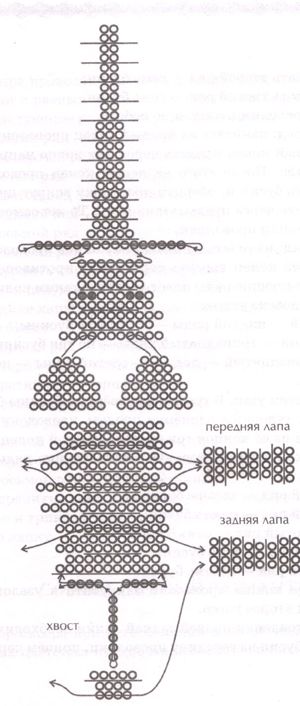 Manufacturer elephant bead starts with the tail.
Manufacturer elephant bead starts with the tail.1 - 2nd series: strung in the middle of the wire eight beads, then thread the wire through the outermost four beads so that they were over the other four beads. 3rd row: strung on a wire, five beads, the other end of the wire to pass through them in the opposite direction. Then connect both ends of wire and thread them through seven beads. Separate the wire ends on each string on four beads. Further drags the trunk of a baby elephant. 1st row: string onto the right end of wire twelve beads on the left wire end to pass through them in the direction from left to right. Successive rows of weave is similar to the first, and the number of beads in each row should read:2nd row of ten beads;
3rd row- twelve beads;
4th row- eleven beads;
5th row- twelve beads;
6th row- eleven beads;
7th row - fifteen beads;
8th row - twelve beads;
9-th row of sixteen beads;
10-th row of ten beads;
The 11th series of fifteen beads;
The 12th row of ten beads;
13th row- thirteen beads;
14th row of ten beads;
15th row- eleven beads;
16th row- eleven beads;
17th row- nine beads;
18th row- eleven beads;
The 19th number - nine beads;
20th row- nine beads, the second, third, seventh, eighth beads should be black — for the eye;
21-th row of seven beads;
22nd row - seven beads;
23rd row of seven beads.
Then go to the weaving trunk.
1st row: string onto the right end of the wire four beads left end to pass through them in the direction from left to right. Then on the left end of the wire to string six beads and wrapping the wire around the sixth beads, thread through the previous five. To do the same with the right end of the wire. 2nd row: strung on any of the ends of the wire, five beads, the other end to pass through them in the opposite direction. The following series also weave with the same number of beads in each row:3 - 6th rows of four beads;
7 - 13th rows with three beads;
14 - 23rd rows with two beads.
Next, weave the ears. In the third and fourth beads 16-th row of the body of an elephant to thread the wire and string on one of its ends three beads, the other end to pass through them from the other side. Subsequent rows, weave the same way:2nd row of four beads;
3rd row of six beads;
4th row- seven beads;
5th row- seven beads;
6th row- eight beads.
The free ends of wire to tighten into a knot, then weave the second ear.
For making the right hind legs need to string eight beads on the middle of the wire, and from the four wire to pass through twice so that the ends came from different sides. So will the 1st and 2nd ranks. The following series are weaved the same way:3rd row- three beads;
4th row- three beads;
5th row- three beads;
6th row- three beads;
7th row - four beads;
8th row - four beads;
9-th row of four beads.
To attach the foot to the body, as shown in the diagram, then weave the left rear paw.
Front feet to spin in the same way as the rear with so many beads:
1st row - four beads;
2nd row - four beads;
3rd row- three beads;
4th row- three beads;
5th row- three beads;
6th row- three beads;
7th row - four beads;
8th row - four beads.
To attach the foot to the body through the Central beads of the 9th and 13th rows, then weave the left front foot. Elephant is ready.




